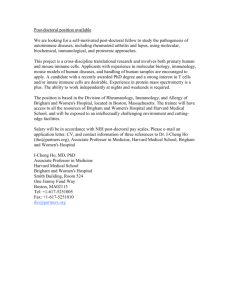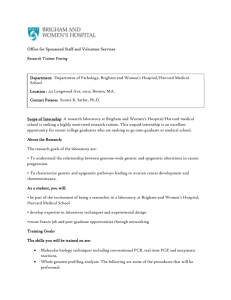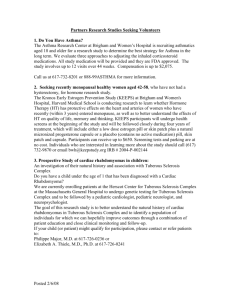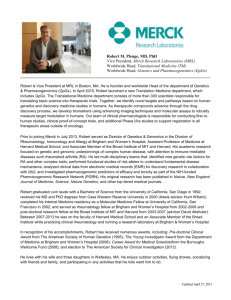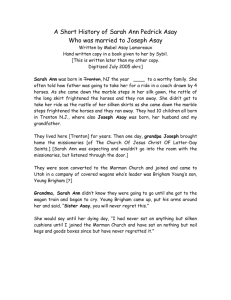BIOGRAPHY OF EVE SUSANNAH JENSEN NICHOLS
advertisement
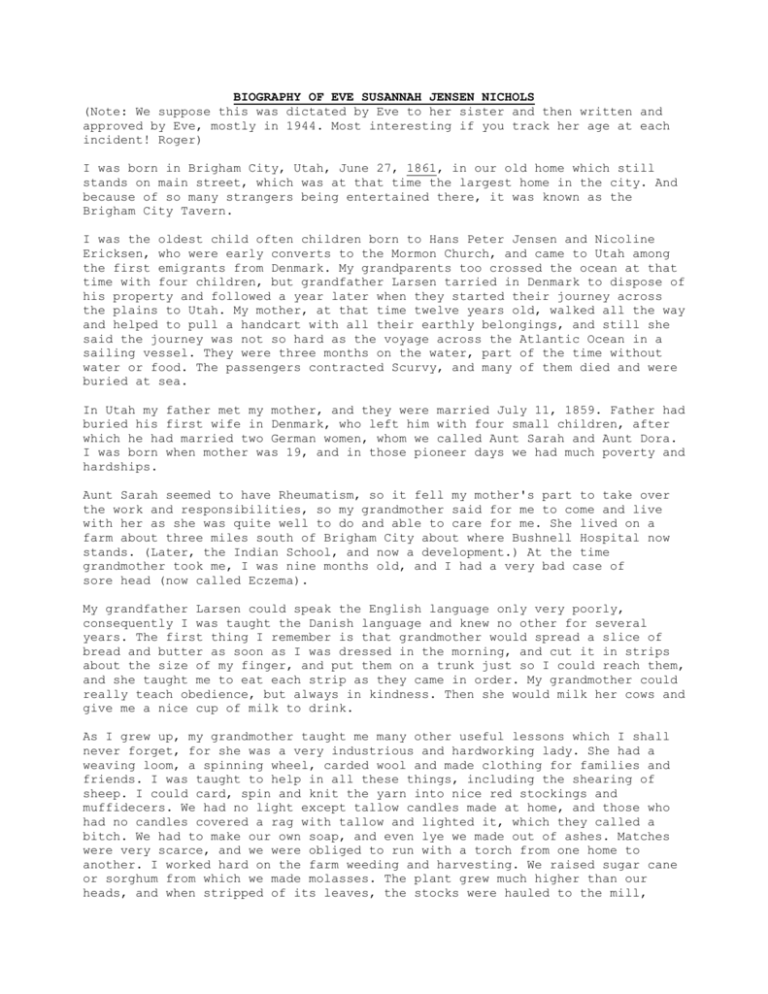
BIOGRAPHY OF EVE SUSANNAH JENSEN NICHOLS (Note: We suppose this was dictated by Eve to her sister and then written and approved by Eve, mostly in 1944. Most interesting if you track her age at each incident! Roger) I was born in Brigham City, Utah, June 27, 1861, in our old home which still stands on main street, which was at that time the largest home in the city. And because of so many strangers being entertained there, it was known as the Brigham City Tavern. I was the oldest child often children born to Hans Peter Jensen and Nicoline Ericksen, who were early converts to the Mormon Church, and came to Utah among the first emigrants from Denmark. My grandparents too crossed the ocean at that time with four children, but grandfather Larsen tarried in Denmark to dispose of his property and followed a year later when they started their journey across the plains to Utah. My mother, at that time twelve years old, walked all the way and helped to pull a handcart with all their earthly belongings, and still she said the journey was not so hard as the voyage across the Atlantic Ocean in a sailing vessel. They were three months on the water, part of the time without water or food. The passengers contracted Scurvy, and many of them died and were buried at sea. In Utah my father met my mother, and they were married July 11, 1859. Father had buried his first wife in Denmark, who left him with four small children, after which he had married two German women, whom we called Aunt Sarah and Aunt Dora. I was born when mother was 19, and in those pioneer days we had much poverty and hardships. Aunt Sarah seemed to have Rheumatism, so it fell my mother's part to take over the work and responsibilities, so my grandmother said for me to come and live with her as she was quite well to do and able to care for me. She lived on a farm about three miles south of Brigham City about where Bushnell Hospital now stands. (Later, the Indian School, and now a development.) At the time grandmother took me, I was nine months old, and I had a very bad case of sore head (now called Eczema). My grandfather Larsen could speak the English language only very poorly, consequently I was taught the Danish language and knew no other for several years. The first thing I remember is that grandmother would spread a slice of bread and butter as soon as I was dressed in the morning, and cut it in strips about the size of my finger, and put them on a trunk just so I could reach them, and she taught me to eat each strip as they came in order. My grandmother could really teach obedience, but always in kindness. Then she would milk her cows and give me a nice cup of milk to drink. As I grew up, my grandmother taught me many other useful lessons which I shall never forget, for she was a very industrious and hardworking lady. She had a weaving loom, a spinning wheel, carded wool and made clothing for families and friends. I was taught to help in all these things, including the shearing of sheep. I could card, spin and knit the yarn into nice red stockings and muffidecers. We had no light except tallow candles made at home, and those who had no candles covered a rag with tallow and lighted it, which they called a bitch. We had to make our own soap, and even lye we made out of ashes. Matches were very scarce, and we were obliged to run with a torch from one home to another. I worked hard on the farm weeding and harvesting. We raised sugar cane or sorghum from which we made molasses. The plant grew much higher than our heads, and when stripped of its leaves, the stocks were hauled to the mill, where the juice was crushed out of them, which was boiled until thick enough to spread upon our bread. The skimmings from the vat were divided among many children, which furnished material for home made candy, so greatly enjoyed at all birthday parties and other festivals. Molasses was almost a perfect substitute for sugar, and preserved the choicest fruits. Among other things, I learned to braid straw hats out of which I earned $50.00 before I was 14 years old. Later I learned to sew the tops of shoes and worked in a shoe shop, and still many children went barefooted in the summertime, and some wore clogs or wooden shoes in the wintertime. Still, life was not so dreary, for we had our sego parties, and we could sing and dance at our birthday parties. Later, I learned to play the organ, and I could play and sing our Sunday School songs, which came in so handy when there was no one else to take charge on the frontier. My hobbies were music, fancy work, and gardening. At first we had only ox teams to ride with, but later we had fine horses and sporty sleighs. One of the great fears of all children was the Indians, who were sometimes hostile. They often demanded food and sometimes stole our cows or horses, and still from them we learned to gather herbs that were good for medicine and for food. When milk was scarce we made tea from the herbs that grew in our gardens to drink with our bread. I did not spend all my young days with my grandparents, but before I left there my own mother received $80.00 from her own father's estate with which she bought the first stove in my father's home. My Uncle Adam also succeeded in deeding my grandmother's farm to my mother and her heirs. Grandfather Ericksen died before my mother was born, and Grandfather Larsen was the father of my Uncle Adam. He was my step-grandfather. My father had three wives in the same house and was a strict Latter-day Saint. He rang a bell every evening for the family to gather for family prayer, scripture reading, and singing. We were a very musical family, and someone was always singing. There was no excuse for absence from prayer. As I grew older, I got very little schooling, for I had to milk cows all my life and help to provide for the other children as they came along. When I did get to school, I did not learn much because the teachers had such strict discipline we were in fear most of the time as we were punished for trivial things. We had very few books, and only a slate and pencil for writing on long tables with benches on either side When I was 16 years of age I began keeping company with my husband, Alvin Willard Nichols, who, at that time, was on a Mission to the Indians at Malad, now called Washikei (Washaki-R). He was called by Brigham Young, and I still have the papers signed by him. Later he was released by John Taylor to move to Logan to take charge of the boarding house for the men working on the Logan Temple, so it was decided that they needed someone to help the girls with the cooking, so I was asked to go with him, and we were married before I was 17, and I went to take that responsibility and stayed 10 months and then came home for Christmas and had my first daughter, Allanna, on January 25, 1879, and I would be 18 in June. There were no means in the Temple treasury so we were really broke. We had no place to live and no way to get even the necessaries of life. It so happened that mother had to go to Mantua to make butter on the co-op farm, so she let us move into her home in the big house in Brigham City for a short time. Mother had her troubles too. She was away from her home most of the time. She had to cook for the men at the Twin Mills 20 miles east of Brigham City, and she cooked for the men who built the first railroad from Ogden to Butte, which was then called "The Utah Northern". In those days the church members lived the "United Order", and father was the manager. He, himself, was a Blacksmith, and in our home factories was manufactured nearly everything we needed in our homes on the cooperative basis, and all laborers were paid in script, which we used instead of money. We built flour mills, woolen mills, saw mills, foundries, and potteries, and I think we had the largest dairy in the Rocky Mountains. The wheels of industry were flying, and we enjoyed a time of prosperity. (You will read of the United Order elsewhere.) I had helped mother so many times before I was married, so she was glad to help me when she could. When spring came, my husband had a chance to buy a lot with a log room on it at the south end of town, where he left me with my baby while he went with my brother, Joe, to do some freighting at Echo Canyon where they were not very successful, but on our lot we had some peaches which we dried and sold to get the necessaries of life, and in that year, Nov. 11, 1880, my second child, a son, Ray, was born. The next spring Alvin tried freighting again out from Corinne but came home again broke. Next he took a contract on the railroad at Soda Springs. I moved up there and lived in a tent that summer, then moved back to Brigham City, and my third child, a boy, Cloy, was born, Oct. 20, 1882. We stayed in Brigham City a short time and then moved to Point Look Out (now Garland) to feed cattle. Then when spring came we operated a dairy making cheese. My third boy, Malcolm Conrad, fourth child, was born Oct. 9, 1884. At that time many Brigham City people had filed on land in that section, but it was discovered that the land belonged to the S.P.R.R. There were bad feelings between the Mormons and the Gentiles at that time, and land troubles and lawsuits continued for many years. Alex Topons and Cow Johnson got most of Point Look Out, and our people lost out. My husband made friends with the enemy, helped the settlers to recover their improvements, and leased most of the land from the enemy, which finally got us into trouble. We lived there a number of years and had a cooperative herd of animals including some good horses and cattle. Then we thought it best to take our animals and move to Idaho. It was in April, 1885. I then had four children, three boys and one girl. My youngest boy was six months old, and the one next to him was just recovering from a very serious case of pneumonia. My husband had driven our animals overland, and our belongings were loaded in a covered wagon, and I was to travel by train and meet him at Market Lake at an appointed time, but he did not arrive in time, and when he did come he was on horseback, and we had only a wagon cover to keep us for the night, and the mosquitoes were terrible. The next morning we got a chance to ride with a man on a load of freight. We had to cross Snake River, which was over flowing its banks, and we had to cross on a ferry boat. We had much trouble getting the cattle across, but on the other side we found plenty of grass, but we had little chance to get food for winter. My husband went to Minnesota to find a market for horses, and while there, he had a real sick spell, and he and his sister, Lovina Gilmore, where he was staying, sent for me, so I finally undertook that hard trip with my four children, which took a whole week because I did not know the way and could not make connections. It was nearing winter, and as I had no home in Snake River, they coaxed me to stay until spring when we returned to Idaho. It was a hard winter, and we left no food for our cattle, and the man we left with the cattle lost many of them. Then my husband invested in a ferry boat on the south fork of Snake River, but the flood water was very high, and the ferry business was not very successful. Then we took up a land claim at what was called "Round Top", a very choice farm three miles from where the ferry boat was running. We had to haul water to the farm with a team, and one day the team backed the wagon over a high bank into the river far below. The men swam to try to save the horses, but only one was saved so we got discouraged and moved to where our farm now is, (Independence) which is now called Thornton, which belonged to the Burton Ward. Here we built a log cabin on the west side of what is called the Texas Slew, and when we found out that most of the south fork came down that way, our neighbors helped us move our buildings to the east side. When we left the farm to go to Rexburg for supplies, we often got lost in the brush and the drifted snow for there were only trails to follow. In Burton we had to help build a ward chapel and organize a branch of the church, which was four miles from our home. My husband was the choir leader, and I was the organist, so the little music I learned from Grandma came in handy. The neighbors were very kind and helped us build a two room log house, but only one room was finished when my first baby in Idaho was born, a girl, Lucy, Nov. 7, 1886. My dear mother came and cared for me. Then, eight in all, we lived, ate, and slept in that one room until nearly Christmas when mother went back home. We still had no telephone and no bridges and mother had to ford slews and ferry across rivers to get to the railroad. That was a hard, lonesome winter, and the next summer the crusade against the Mormons for Polygamy was on. The post office was taken away from us, and we were otherwise hindered in our civil rights but eventually our rights were restored again. The next winter we sent our two oldest children to Utah to attend school, and the next winter the church instituted a school of our own in Rexburg, where we hired our own teachers. This institution grew to be the Ricks College (now “BYUIdaho”), which still stands. In the summer of 1888, my husband went out canvassing a very interesting veterinary book as he was more interested in horses than in farming, and while he was on one of his trips, I was confined with another baby girl, Ada, born July 15, 1888. I was compelled to rely on my neighbors for help, and they lived far apart. I sent for my brother-in-law Spaulding by my small children, and he drove to Rexburg and got a midwife out of the church for there were no doctors in those days, and my husband arrived home three days too late. It was hot weather, and flies and mosquitoes were plentiful, and I did sweat plenty. I can never forget that soon after this the experience I had saving the life of my little boy. We raised a pet lamb, which grew to be a powerful buck sheep. There were no men on the farm, as usual, and while I was staking a horse, I heard the cries of my boy and saw the buck bent over him and attempting to kill him, and I had to think quick. I tackled the buck with the ax and saved his life, and I am sure at no other time could I have licked the sheep! My next daughter, Lottie, came Feb. 28, 1891, and she came before father could get back with the midwife. I had only a neighbor lady present, but all ended fairly well. Aug. 1, 1893, another girl, Almeda, came along. She had a bad case of the sore head as I had when I was a baby, which has been a real trial for many mothers. She had hardly recovered when another girl came along to our home July 20, 1895. Her name was Ella, and she came while the ward was putting on a program, and they had a neighbor lady come and take care of me while my husband and daughter conducted the program; so that night both of my babies were sick, and I had to care for them, and that was the most serious case of child bed I had. Still, with the Lord's help, I survived. Then my next daughter, Leola, came, May 14, 1897, which was real serious, as I was four miles from home and had an accidental hemorrhage and had to be taken home riding on a spring seat with the team on the run, and then to wait to get a midwife, and only with the help of the Lord did I again recover. It seemed I had not yet received my allotment, for on July 27, 1899, another daughter, Cleo, came, and still another, Elva, came July 9, 1901, making eight girls in succession, in answer to my oldest girl's prayers, ha-ha. Then two years later, June 20, 1903, a son, Ezra Leland came, and two years later, Sept. 18, 1905, our 14th child, a daughter, came, but stayed with us only until morning. We had, I think, all kinds of contagious diseases, which leaves some weaknesses in the health of all of us to a certain extent, but the Scarlet Fever served us the worst of any, for it cost us the life of my one little girl, Ella, at the age of nearly five. We could not get doctor's help, so after lingering two months, she died March 3. We could hardly get to the cemetery, the roads were so bad. Two of the other girls were seriously afflicted at the same time, and we were quarantined, so we could not get out, and we had no one to help us, and just four months from this time Elva was born. I am thankful to say the Lord has helped me through all these times. We have sent five of our children on missions, and I appreciate the Gospel more every day. At this writing, I am 83 years old, and have 117 descendants of which I am very proud. They are all kind and very good to me, and I want most of all to leave my testimony with them that God lives and hears our prayers. Post Script— I have raised 12 of my children to have children of their own, and I have been a widow 17 years. Seven of our 14 children are now on the other side with their father, so we are equally divided at this date. About 1910, I had a serious female operation. Added note by the writer: At the conclusion of this short biography, which I have many times pleaded with my sister to write, I wish only to say to the reader that one must read between the lines to get the wonderful inspiration from this wonderful pioneer woman. She told me that her life was too sad to be written, and she is too modest to use even the little schooling she has had to write any details for fear someone might take offense or that her experience might not be modern. From my earliest childhood, I can verify every experience she has mentioned including some of those unforgettable happy days in Grandma Larsen's home. I was with her when my sister cooked for the men who built the Logan Temple, and when she cooked for the men who built the Bothwell Canal, and I have been close to her during most of her experiences in life. I helped her drive her cattle to Rexburg in 1885, and I helped her harvest her crop on the homestead in l900. I was in Brigham City when she returned from Minnesota with her 5 little kiddies, and I helped the family eat bran bread that winter in my mother's home when we ran out of flour. I was also in Brigham City to welcome her on her most marvelous pilgrimages from Rexburg to Brigham City for her annual supply of fruit with which to feed her large family. I say marvelous pilgrimage because no pioneer who ever crossed the plains had a more venturesome experience. She loaded all her little children into a covered wagon and drove her own team about 700 miles over unimproved roads, and over dangerous streams, and through Indian infested territory, depending upon the native grass for the horses' feed, and mostly upon magpie eggs and fish to feed herself and family, as I did when I drove the cattle to Rexburg. I personally had the honor of driving this famous caravan drawn by old Tom and Nelly from Brigham to Park Valley, about 200 miles, to visit Uncle Adam and brother Nels at their stock ranches. I was also familiar with some of the sickness and poverty witnessed in cabin on the homestead, and I watched the family grow to maturity. Her supply of fruit was taken to their homestead mostly in five gallon oil preserved in molasses, or if she ran out of cans, she waited until the dry enough to move in sacks. their log annual cans, fruit was Since those days my sister has paid me in full for every deed I did for her in the care of my own family. One of my children was born in her home, one of them died there, and we have enjoyed her love and hospitality always. She has always been an angel of mercy and has always given more than she has received. It is so sad that so many of her dear ones have recently been called home and left her to mourn, still, she acknowledges the hand of God in all things, and her last days are comfortable. I am sure all of her descendants and kinsmen will join me in trying to make the remainder of her days happy, may the whole world profit by the example of this great woman. The author of this account of Eve's life is unknown. It may have been her sister, Lottie Jensen Gamble.
